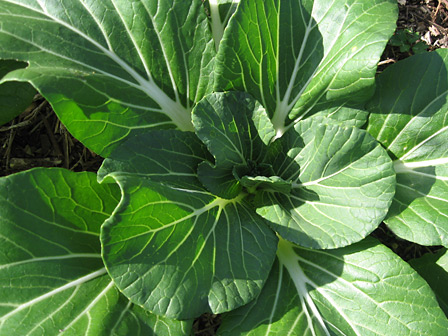Ever since we planted the first bok choi seeds, I’ve been thinking about how good it would be to make some bok choi kimchi (kimchi is a Korean-style sauerkraut). Finally, our bok choi is ready to harvest, and we are engaged in our much-anticipated bok choi kimchi experiment.
 Bok choi, ready to harvest
Bok choi, ready to harvest
Kevin and I are very fond of lactic fermented vegetables, which have become a regular part of our diet since we moved here. Lactic fermented foods contain lots of health-giving enzymes and vitamins. Lactic fermentation is a simple traditional way to preserve food without losing nutritional value. Actually, the process adds nutritional value to the food — like making yoghurt out of milk. They also taste delicious — less acidic and more mellow/complex than vinegar pickles.
In case you are interested, the recipe book, Nourishing Traditions, by Sally Fallon, has some good recipes and guidance for making lactic pickles. It really helped us get started. If I’d known it was that easy to make your own fermented vegetable pickles, I’d have started doing it much sooner. Wild Fermentation, by Sandor Ellix Katz, might be another good book to look at. This book is on my wish list, as I think it might give us more interesting ideas and recipes to work with. Maybe we’ll get it next time we are putting in an order with Amazon.
We’ve made various different kinds of lactic pickles in our little kitchen here, but this is the first time we have produce from our own garden to ferment. It feels like a small milestone!
I’ve never tried to make kimchi out of bok choi before, so let’s hope it works ok. I’ll post the outcome in a few days!
Here’s the recipe:
Bok Choi Kimchi
7 heads of bok choi, cut into quarters lengthwise
1 1/2 tablespoons of sea salt
1/2 teaspoon of chile flakes
2 tablespoons of fresh ginger, finely chopped
5 cloves of garlic, minced
4 tablespoons of whey (You can get whey by putting some live natural yoghurt in a cloth, and collecting the liquid that drains out of it.)
Method: Mix all ingredients together in a big bowl. Pound and crush the bok choi to release some of the juices — without completely pulverising it. Leave the mixture to sit for a few minutes to draw out a bit more moisture. Now put the mixture into a large preserving jar, pressing it down to pack it in, and so that the liquid comes up to cover the vegetables. Leave about 3cm of space at the top of the jar, since the kimchi will expand a bit as it ferments. Close the lid firmly, and keep at room temperature for 3 days. Now it should be ready to eat.
 Kimchi
Kimchi
You can now store the kimchi in the fridge or root cellar, where it will keep for several months. The taste is good immediately, but improves as the kimchi matures.
Slug Update
You might remember that we were having a problem with slugs devouring our bok choi plants. Somehow, with my nightly slug hunts and our beer traps, the slugs have been kept under control, and we will get to eat most of the bok choi. Farmlet reader, DR, has suggested using coffee as a slug and snail repellent. We are keen to try this trick. Also, BB suggested using khaki campbell ducks to eat the slugs. We like this idea too. Khaki campbell ducks are supposed to be wholly carniverous, so would not eat the seedlings. I’m still a bit worried that the ducks might kill seedlings by standing or sitting on them, though. Has anyone out there had experience with khaki campbell ducks in a vegetable patch?




